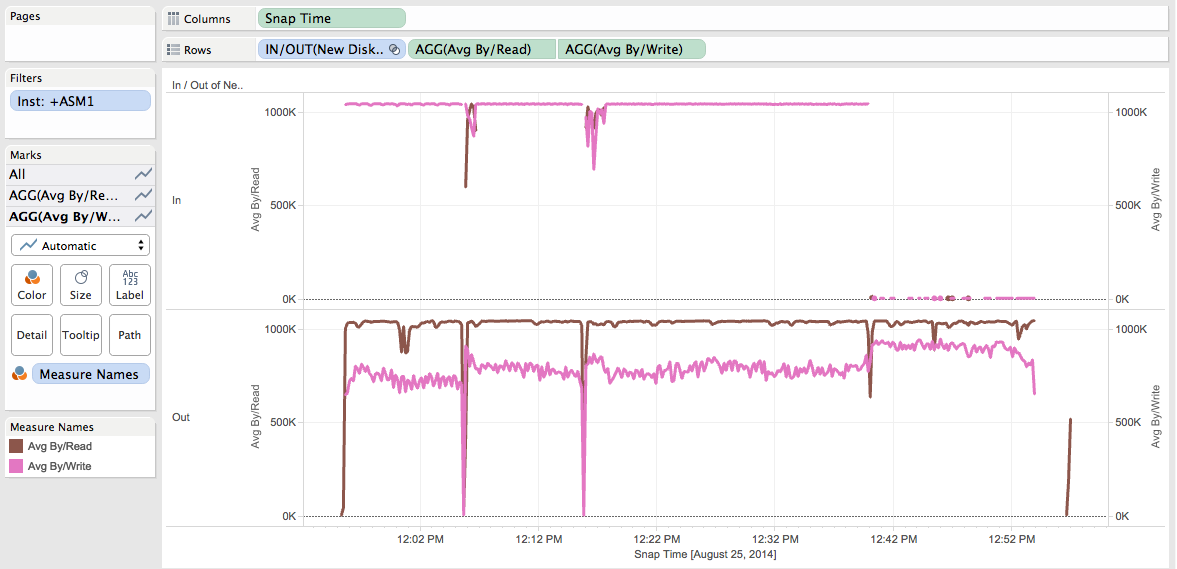During the “A closer look at ASM rebalance series” I observed that the average By/Read extracted from the v$asm_disk_stat view during a rebalance is equal to 1MB even if the ASM allocation unit is set to 4MB.
Example:

The question is: why?
To try to answer this question I decided to use strace (the Linux system call trace utility) on the ASM arb process (this process rebalances data extents within an ASM disk group) during the rebalance of the DATA diskgroup (AU size is 4MB).
From strace I can see:
- That a very large majority (more than 80% in my case) of the IOs are submitted that way:
io_submit(140691479359488, 4, \{\{0x7ff547f6c210, 0, 0, 0, 261\}, \{0x7ff547f6d0b0, 0, 0, 0, 261\}, \{0x7ff547f6c960, 0, 0, 0, 261\}, \{0x7ff547f6cbd0, 0, 0, 0, 261\}\}) = 4
We can see that 4 IOs have been submitted at the same time (with a single io_submit call).
- And that about 100% of all the IOs submitted are 1MB (look at the IO size which is 1048576 bytes):
io_getevents(140691479359488, 1, 128, \{\{0x7ff547f6c960, 0x7ff547f6c960, 1048576, 0\}, \{0x7ff547f6cbd0, 0x7ff547f6cbd0, 1048576, 0\}, \{0x7ff547f6d0b0, 0x7ff547f6d0b0, 1048576, 0\}, \{0x7ff547f6c210, 0x7ff547f6c210, 1048576, 0\}\}, \{600, 0\}) = 4
I also straced arb during the rebalance of the DATA1M diskgroup (Allocation unit of 1MB) and observed:
- That about 80% of the IOs are submitted that way:
io_submit(139928633700352, 1, \{\{0x7f43aadbd210, 0, 1, 0, 262\}\}) = 1
So 1 IO is submitted per io_submit call.
- And that about 100% of all the IOs submitted are 1MB:
io_getevents(139928633700352, 3, 128, \{\{0x7f43aadbd6f0, 0x7f43aadbd6f0, 1048576, 0\}\}, \{0, 0\}) = 1
So that it makes sense to conclude that:
- The arb process always request IOs of 1MB (whatever the allocation unit is).
- The arb IOs requests are grouped and submitted at the same time depending of the diskgroup allocation unit (4 IOs are submitted at the same time with allocation unit set to 4MB, 1 IO submitted by io_submit call with allocation unit set to 1MB).
Based on this, I think it makes sense that the v$asm_disk_stat view reports Avg By/Read of 1MB during the rebalance process (whatever the allocation unit is).
But now one more question: What is the impact of the Linux Maximum IO size?
For this, I launched the rebalance 2 times (on both diskgroups: DATA with AU=4MB and DATA1M with AU=1MB): One time with max_sectors_kb set to 512 and one time with max_sectors_kb set to 4096.
And observed that:
- Oracle still does 1MB IOs only and groups the IOs depending of the allocation unit (whatever the max_sectors_kb is).
- With max_sectors_kb set to 512: The IOs issued on the devices linked to the ASM disks are limited to 512 KB (even if oracle requested 1MB IOs). This can be seen with the iostat output (looking at the avgrq-sz field):
Device: rrqm/s wrqm/s r/s w/s rsec/s wsec/s avgrq-sz avgqu-sz await svctm %util
sdak 0.00 0.00 0.00 13.65 0.00 13919.15 1019.72 0.04 3.11 3.11 4.25
sdbd 0.00 0.00 0.10 0.00 102.05 0.00 1020.50 0.00 2.00 2.00 0.02
sddh 0.00 0.00 0.15 0.00 153.25 0.00 1021.67 0.00 4.33 4.33 0.07
sdej 0.00 0.00 0.00 12.35 0.00 12640.10 1023.49 0.04 3.01 3.01 3.72
sdcr 0.00 0.00 0.00 11.80 0.00 12083.20 1024.00 0.03 2.71 2.71 3.20
sdfi 0.00 0.00 0.00 12.35 0.00 12646.40 1024.00 0.07 5.55 5.55 6.85
sdg 0.00 0.00 0.00 11.70 0.00 11980.80 1024.00 0.06 5.35 5.34 6.25
The avgrq-sz is the average size (in sectors) of the requests that were issued to the device. The sector size I am using is 512 bytes (not 4K) so that the IOs are about 1024*512 bytes = 512 KB (which is our max_sectors_kb size).
- With max_sectors_kb set to 4096: The IOs issued on the devices linked to the ASM disks can be greater than 1MB (even if oracle requested 1MB IOs):
Device: rrqm/s wrqm/s r/s w/s rsec/s wsec/s avgrq-sz avgqu-sz await svctm %util
sdi 0.00 0.00 3.75 2.05 20173.15 2253.60 3866.68 0.17 29.72 28.79 16.70
sdas 0.00 0.00 3.90 1.95 20992.35 1638.80 3868.57 0.18 31.08 29.91 17.50
sdgj 0.00 0.00 3.75 2.00 20173.85 2253.20 3900.36 0.20 34.71 33.74 19.40
about 2MB in my case (3900 * 512 bytes).
Remarks:
- It has been tested with ASM 11.2.0.4 on Linux x86-64 (without asmlib).
- I’ll update this post with ASM 12c results as soon as I can (if something new needs to be told).
Conclusion:
- The arb process always request IOs of 1MB (whatever the allocation unit is).
- The arb process always request IOs of 1MB (whatever the max_sectors_kb is): Then it looks like arb doesn’t probe the IO capabilities of the associated device.
- The arb IOs requests are grouped and submitted at the same time depending of the diskgroup allocation unit.
- The kernel splits the arb IOs requests if max_sectors_kb is < 1MB.
- The kernel try to merge the arb IOs requests if max_sectors_kb is > 1MB.
Thanks to Frits Hoogland for his “Extra huge database IOs series” and for the time he spent answering the questions I asked.